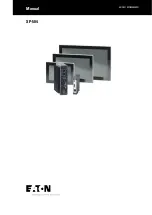
19
Heaters operation
Topics Covered in this Chapter
Heater operation: how it works
Heater page and tile information
Heater operation: how it works
Heating systems are meant to maintain house/barn or zone temperatures close to the house/barn set
point.
The EDGE controller can handle different types of outputs for Brooder:
• On-Off a relay for a single capacity heater
• Variable (modulated, with or without relay)
• Dual intensity High-Low (2 relays: 1 relay =Low, 2 relays =High)
A heater output can activate many types of devices such as gas heaters, Brooders, hot air furnaces, elec-
tric radiant units, and modulating hot air furnaces and modulating gas heaters.
Heating operation depends on the following:
• House/barn temperature
• House/barn set point
• Control mode
• Relative humidity
Heater operation logic
To operate a heater, the controller refers to the average reading of the temperature sensors assigned to
the heater. The operating temperatures of the heater can either be related to the house/barn set point
with and offset, which means that heater operational temperatures are automatically adjusted when the
house/barn set point changes. House/barn set point can also be dictated by a curve. A change to the
house/barn set point induces all heating operation reference temperatures to shift accordingly. There is
no restriction to the start temperature, except for the minimum and maximum settings.
Zoned heating
Each zone can be covered by a heating system and assigned to zone temperature probes. These zones
are related to a zone heater that might be turned on and off depending on the desired temperature in the
zone. Usually, zones work with the same settings, but each zone can have its heat start/stop tempera-
tures related to the house/barn set point
Electric radiant
The EDGE controller can use its silicon controlled rectifier (SCR) to drive electric heater power outputs for
devices such as electric heat coils or electric radiant. Then the output can have a variable intensity.
895-00693
EDGE
147
Summary of Contents for EDGE 890-00601
Page 16: ...Chapter 1 Introduction 16 895 00693 EDGE...
Page 22: ...NOTES 22 895 00693 EDGE...
Page 26: ...Chapter 2 Basic connections Figure 2 1 EDGE 3 Slot Expansion Box 26 895 00693 EDGE...
Page 44: ...NOTES 44 895 00693 EDGE...
Page 52: ...NOTES 52 895 00693 EDGE...
Page 60: ...NOTES 60 895 00693 EDGE...
Page 76: ...NOTES 76 895 00693 EDGE...
Page 108: ...NOTES 108 895 00693 EDGE...
Page 110: ...Chapter 11 Test mode 110 895 00693 EDGE...
Page 128: ...NOTES 128 895 00693 EDGE...
Page 132: ...NOTES 132 895 00693 EDGE...
Page 138: ...NOTES 138 895 00693 EDGE...
Page 140: ...NOTES 140 895 00693 EDGE...
Page 142: ...NOTES 142 895 00693 EDGE...
Page 146: ...NOTES 146 895 00693 EDGE...
Page 150: ...NOTES 150 895 00693 EDGE...
Page 154: ...NOTES 154 895 00693 EDGE...
Page 156: ...NOTES 156 895 00693 EDGE...
Page 158: ...NOTES 158 895 00693 EDGE...
Page 176: ...Chapter 26 Test mode 176 895 00693 EDGE...
Page 188: ...NOTES 188 895 00693 EDGE...
Page 192: ...NOTES 192 895 00693 EDGE...
Page 194: ...NOTES 194 895 00693 EDGE...
Page 202: ...NOTES 202 895 00693 EDGE...
Page 204: ...NOTES 204 895 00693 EDGE...
Page 206: ...NOTES 206 895 00693 EDGE...
Page 214: ...NOTES 214 895 00693 EDGE...
Page 216: ...NOTES 216 895 00693 EDGE...
Page 218: ...NOTES 218 895 00693 EDGE...
Page 220: ...NOTES 220 895 00693 EDGE...
Page 224: ...NOTES 224 895 00693 EDGE...
Page 226: ...NOTES 226 895 00693 EDGE...
Page 230: ...NOTES 230 895 00693 EDGE...
















































